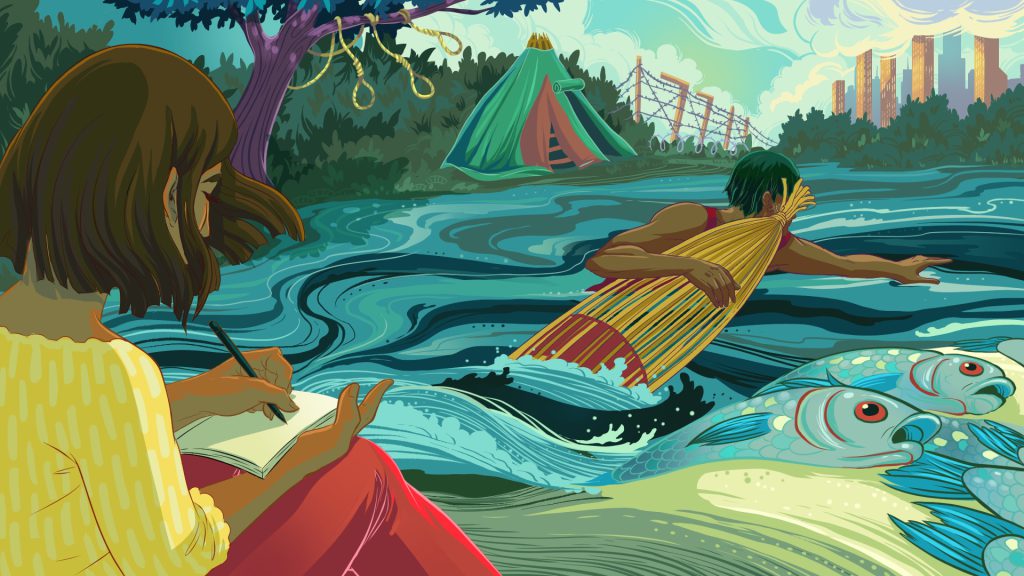Why Poetry + Anthropology?

When a barbed-wire de facto border lights up but throbs with blood, when a lynching memorial veins into memories and questions of the soul, when a returning migrant wears the trauma of Juárez, when poverty clings like a ghost, when flashes of floodlights spawn fear, or when traditions are revitalized and initiated back into a community—we are grateful that an anthropologist-poet was there to bear witness with heart, pen, and paper.
SAPIENS’ first poetry project celebrates such “anthro-poets” with the publication of the five winning poems from our recent call for literary anthropological poems. We thank all who submitted! We were astounded by the wonderful response and were moved by each of the entries.
In our first featured poem, “The Fish Trap” by Glenn H. Shepard Jr., published today for World Poetry Day, the poet-anthropologist Shepard witnesses an Amazonian fish trap’s “hybrid carcass of palm staves” held by vines and a coil of copper wire. In this earthy, midnight poem, the author steps us through concrete objects hooked to what appears to be culture change—the fish trap’s function standing in, “not lost but transformed” as fuel for the fire. A haul net in the distance rests near fish sucking at the “futile night.” We as readers feel transformed by the “red halos” that “ebb behind open eyes.”
The sense of a particular place under a “smothered moon” comes into sharp relief. The tension of change as loss, change as transformation pulls and shifts like white sand under foot.
What do anthropological poems bring to us?
Sensations, emotions, ironies, hopes, traumas, urgencies, disruptions, understandings—what it means to be vitally human and to make sense of the human experience.
Excavations into chambers underneath generalities and abstractions leave the reader at times breathless, raw, open-hearted, questioning. Specific places around the globe are unveiled by skilled hands, viewed with empathetic eyes, written about with crafted sensitivities that listen to how sound and sense matter and reflect. What comes into view are people, places, histories, environments, and political situations. We as readers find ourselves, in turn, surprised and seeing things in a new light through each author’s deft use of description, metaphor, rhythm, line breaks, rhyme, and voice.
But more, we discover a poetry that matters. The incisive critique of the insular state of poetry in the U.S. that poet Dana Gioia leveraged in 1991, which sent many poets, editors, and literary critics into deep self-analyses, has no hook here among contemporary anthro-poets. Although many are based in universities, yes, they are “directed outward,” not “focused inward.” Anthropologist-poets, alongside other contemporary poets, help restore poetry’s “intellectual and spiritual influence.”
And even as many authors articulate a marriage of “the personal to the ambitiously political,” teasing out threads informing identity formation, cultural constructions, and influential power structures, among other social forces, they expand into other territories to put words to disrupted familiarities and surprising commonalities.
How are anthropological poems different from other poems? What stands out is their unusually deep engagement with the world and its inhabitants (human and nonhuman) in all of their diversity—in contrast to literary works that center on a more cerebral, psychological, individualistic point of view that washes again and again over inner landscapes. With anthropological poems, we see a trained observer in the world, feeling the world, engaging the world, not apart from but of—often trying to relate across human differences.
Unveiling an “invisible city” in Qatar, stepping into minefields metaphorical and physical, taking stock of human rights violations, and enlivening a fire inside a lavvu (a movable living structure) with a silent song among Sami herders, these authors share their toolkits with us for awakening the imagination of a shared humanity that celebrates its diversity.
By disentangling language from an inherited colonial gaze, anthro-poets deliver us into an empathetic gaze.
Engaged with the world, not turning away, these anthro-poets help us learn to see—slowing down the breath, frontal lobe, and eye to unpack biases, unconscious reactions, limbic hums.
In a world where culture contact has become the norm and in the midst of dire emergencies both local and global, we ask: How has my cultural upbringing shaped what my senses take in? How can I unlearn, become an attentive witness, and experience the human family without reducing, for example, its 7,000 languages to a narrow series of shared alphabets? How do I transform impulses to ignore, override, essentialize, or force assimilation of difference?
Anthropological poems right the window: They start with human moments, lived experiences. Their foundation rests in fieldwork—in ethical participant observation—which “adds spaciousness to poetry,” writes anthropologist-poet Leah Zani, who is also the poetry editor at the scholarly journal Anthropology & Humanism. They gain traction through how the author makes meaning out of those moments and reflects on experiences using social theories that, in turn, birth new frameworks for understanding.
How can this kind of poetry reveal what it means to be human in particular places?
We find our way forward through the stanzas of “vulnerable observers.” For some poet-anthropologists, this means crafting autoethnographic works to complement their scholarly writings. By weaving personal experiences into the subject of focus, as in Justin D. Wright’s “The National Lynching Memorial Speaks to My Black ’Bama Body,” these poets help us stand in front of “a place made to be left, a space made to leave a hope upon, an altar.” A witness bearing history, bearing a Black ’Bama Body, becomes an embodied voice reminding, “The history of this land is a history of trauma.”
In an autoethnographic journey through a lynching memorial, readers learn to overcome any residual blindness—our manipulated ignorance of the horrors of a racialized past and present.
By disentangling language from an inherited colonial gaze, anthropologist-poets deliver us into an empathetic gaze through which we can start to know “others” and ourselves—and our shared histories—anew.
In a time when scientists and scholars are increasingly turning to poetry to communicate and make sense of the world, we invite you to enjoy and take part in these poems that are rooted in and breathing through specific human stories and sites around the globe—as witnessed and recorded by these anthropologist-poets with heart, pen, and paper.
































